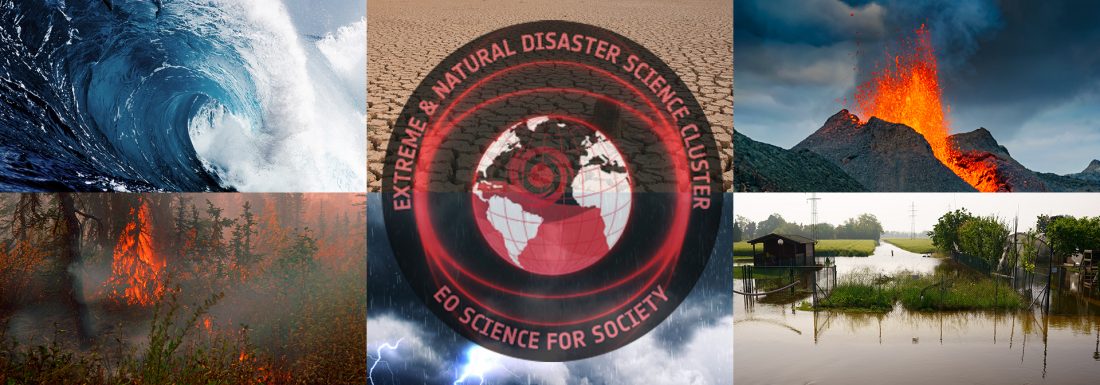The ESA Extremes and Disaster Science Cluster is launched to promote networking, collaborative research, and international collaboration in the domain of Earth Observation for climate extremes and disaster related EO research. It will involve several ESA-funded projects and activities bringing together different expertise, data, and resources in a synergistic manner to ensure that the result may be larger than the sum of its parts.
The Cluster goals include:
- Advancing the observation capacity and scientific understanding of the drivers and processes leading (in terms of precursors, hazards, impacts and forecasts) to extremes and high-impact hydroclimatic events, including among others wildfires, heatwaves, droughts, floods, and storms.
- Improving the observations and holistic understanding of connected multi-hazards (including compounding and cascading atmospheric, climatic, and geo-hazards) and their impacts on our society and ecosystems.
- Advance our capacity to better prepare and adapt to climate risks and geo-hazards.
Addressing these goals will require a significant collaborative effort and an integrated approach to science where the synergistic use of EO satellite data, in-situ and citizen observations, advanced modelling and AI capabilities, interdisciplinary research and new technologies will be essential elements.
To this end, activities under this Cluster will also contribute to the joint EC-ESA Joint Earth System Science Initiative, where ESA and the European Commission Directorate General for Research and Innovation (DG-RTD) aim at jointly advance Earth System Science and its contribution to respond to the global challenges that society is facing at the onset of this century.
List of relevant Earth Observation science projects
Earth Observation Advanced science Tools for Sea level Extreme Events (EOatSee)
The EOatSEE project aims to enhance the understanding and prediction of Extreme Sea Level (ESL) events and their coastal hazards through advanced Earth Observation technology. It focuses on three main scientific domains: predictability of ESL flooding hazards, understanding the impact of ESL on long-term coastal evolution, and assessing coastal risk and vulnerability. Utilizing a blend of high-resolution modeling and empirical approaches, EOatSEE also includes a pilot program for knowledge transfer to early adopters in vulnerable areas. The initiative seeks to inform future scientific activities and support decision-making through improved EO products and modeling tools.
Read moreEarth Observation for high-impact multi-hazards (EO4Multihazards)
EO4MULTIHAZARDS leverages satellite Earth Observation to enhance understanding of cascading and compounding multi-hazard events, aiming to reveal their dynamics and assess societal and ecological impacts. The project focuses on advancing scientific knowledge through four science cases, fostering collaborations with local and international initiatives, and engaging with a diverse scientific community. Key efforts include developing practical evaluation tools, creating an Open Multi-Hazard Events Database, and supporting early warning systems through stakeholder collaboration. The project’s outcomes will be disseminated via scientific publications and public materials, contributing significantly to European multi-hazard research and disaster risk assessment.
Read moreAI-enhanced uncertainty quantification of satellite-derived hydroclimatic extremes (ExtrAIM)
The project aims to develop a low-latency, uncertainty-aware precipitation dataset for the Mediterranean. Utilizing statistical learning, Bayesian modeling, and AI-enhanced data integration, extrAIM will combine multiple precipitation products to improve understanding and characterization of hydroclimatic extremes. Key objectives include creating an explainable AI approach, a probabilistic framework for uncertainty modeling, and a user-friendly data visualization platform. This platform will aid in risk communication of extreme events.
Read moreDeepExtremes
DEEP EXTREMES focuses on global compound heat and drought events by combining long-term climate and land-surface data with Earth Observation archives for multivariate event detection. The project samples large events from the Sentinel era, zooming into affected and unaffected areas with high-dimensional “mini cubes,” and trains deep-learning methods for prediction and understanding event dynamics. Implemented in a cloud environment, the project seeks to refine its workflow based on community feedback and engage the scientific community through workshops and discussions.
Read moreAI4Drought
AI4DROUGHT aims to predict drought events over the Iberian Peninsula using deep learning architectures to maximize data extraction from EO-based datasets and Seasonal Prediction Systems (SPS). By combining Earth observations with SPS through AI algorithms, the project enhances understanding of drought causes and effects. The scalable and transferable methodology integrates numerical climate models with AI to identify multi-hazards and cascading effects.
Read moreMedicanes
MEDICANE aims to exploit EO data to advance the understanding of medicane dynamics, improve forecasting of their timely occurrence and quantify the limitations of atmospheric modelling when reproducing relevant high-impact weather.
Read moreARCEME
ARCEME aims to develop a comprehensive framework for assessing multi-hazards through various angles and scales, integrating EO archives with other observational data for multivariate event detection. It focuses on analyzing large events within the Sentinel era, understanding event dynamics, and evaluating land management resilience against multi-hazards. The project will share its workflow in a cloud environment, refining it with community feedback, and actively engage with the community through workshops and discussions to evolve the framework. Read more
ARNETLAB
ARNETLAB aims to advance understanding of how atmospheric rivers (ARs) drive hydrological extremes and influence terrestrial ecosystems. As global climate change intensifies the water cycle, extreme weather events such as heavy precipitation are expected to become more frequent and severe, yet the links between these atmospheric phenomena and land-surface processes remain poorly understood. To address this gap, ARNETLAB introduces a multi-layer network framework to analyze interactions between the atmosphere, hydrology, and land ecosystems. Read more

